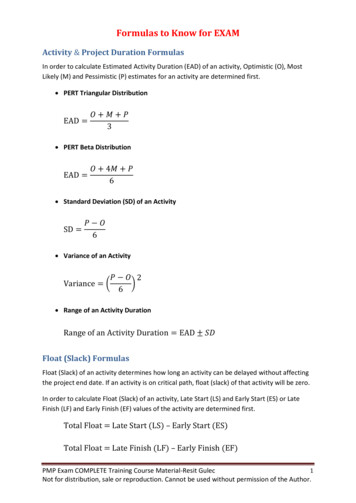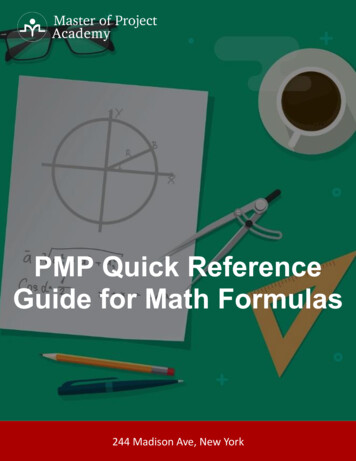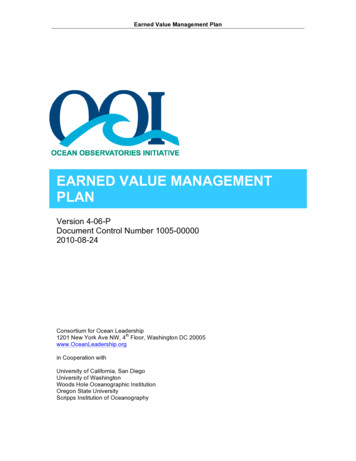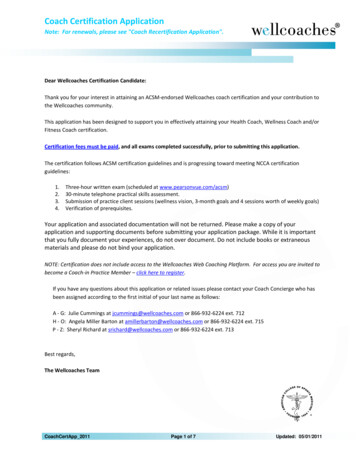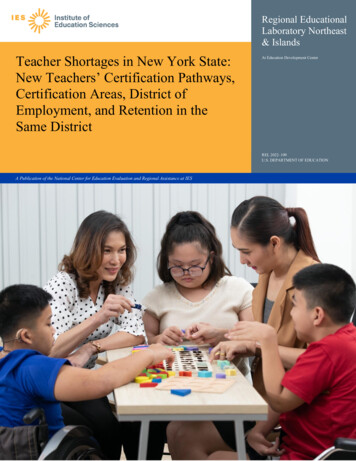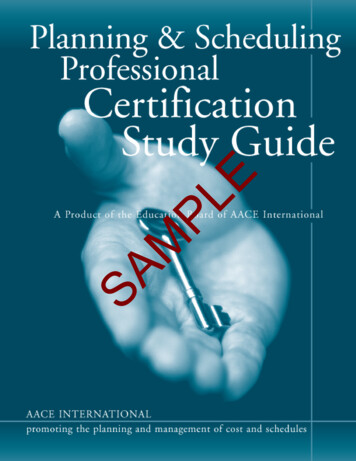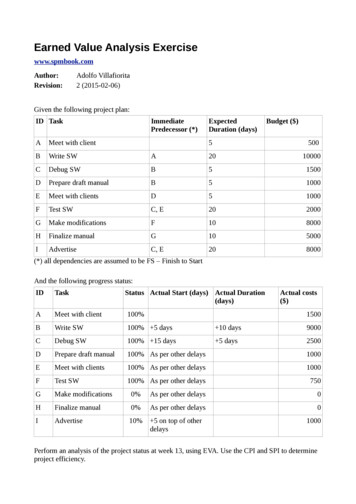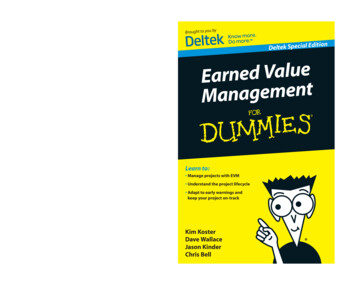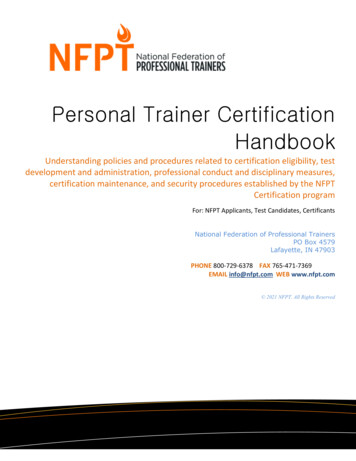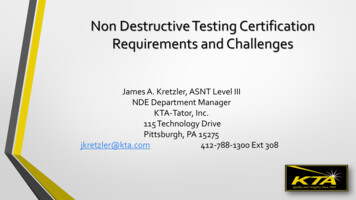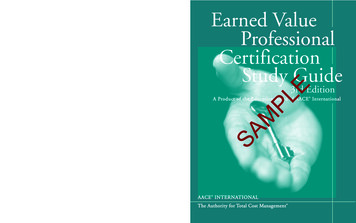
Transcription
EPL3rd EditionSASean T. Regan, FAACE CCP CEP, Editor1265 Suncrest Towne Centre Dr.Morgantown, WV 26505-1876 USAPhone: 800-858-COST or 304-296-8444Fax: 304-291-5728E-mail: info@aacei.orghttp://www.aacei.org A Product of the Education Board of AACE InternationalMEarned Value Professional Certification Study GuideEarned ValueProfessionalCertificationStudy Guide AACE INTERNATIONALThe Authority for Total Cost Management
AACE InternationalEVP Certification Study GuideAACE InternationalEEarned Value Professional(EVP)Certification Study GuidePLThird EditionSAMEditorSean T. Regan, CCP CEP FAACE2015 2014, AACE International (All Rights Reserved)Page 1
EVP Certification Study GuideAACE InternationalEarned Value Professional(EVP)Certification Study GuideE 2015 by AACE InternationalAll rights reserved. Published 2015Printed by CreateSpacePL1265 Suncrest Towne CentreMorgantown, WV 26505-1876 USAPhone: 1 (304) 296-8444Fax: 1 (304) 291-5728E-mail: info@aacei.orgWeb: www.aacei.orgSAMISBN—13: 978-1502315960ISBN—10: 1502315963Page 2 2014, AACE International (All Rights Reserved)
AACE InternationalEVP Certification Study GuideA Special Publicationof AACE International–The Authority for Total Cost ManagementEarned Value Professional (EVP)Certification Study GuidePLE2015SAMA continuing project of the AACE International Education BoardWith collaboration from theAACE Certification Board and AACE Technical Board 2014, AACE International (All Rights Reserved)Page 3
EVP Certification Study GuideAACE InternationalAcknowledgmentsThe 2013/2014 AACE International Education Board is grateful to the following individuals andcompanies who have assisted in the development of the EVP Certification Study Guide, Third Edition:Editor: Sean T. Regan, CCP CEP FAACEAuthors:Marlene M. Hyde, CCP EVPRay Stratton, EVPDr. Paul Giammalvo, CCPChris Boyd, CCP CEPElena RybinaSean T. Regan, CCP CEP FAACE MRICSEReviewers:PLLarry Dysert, CCP CEP DRMPTony Woodrich, CCPRobert Loop, EVP PSPScott Sanford2013/2014 Education Board Members:Ann Marie Cox, EVP (Co-Chair)Mark T. Chen, PE CCP FAACEClive D. Francis, CCP FAACEDr. Mark Hastak, PE CCPMarina G. Sominsky, PSPSean T. Regan, CCP CEP FAACE MRICSJames G. Zack, Jr. CFCC FAACE FRICSCarole Ann Venters CCP EVPSAMPeter W. Griesmyer (Chair) FAACEChris A. Boyd, CCP CEPDr. John O. Evans, III PSPDonald F. McDonald, Jr. PE CCP PSP FAACEDr. Don Mah, P.EngSunu M. Pillai, CCP EVP PSPRohit Singh, P.Eng. CCPMarlene M. Hyde, CCP EVPDr. Baabak Ashuri, CCPAACE International and the Education Board would like to give special thanks to Jacobs Engineering,Administrative Controls Management, Inc. (ACM), PMSOFT Group of Companies, ManagementTechnologies, and LGM International, LLC, for the time and support they provided to the writers andeditors of this document. Without their support and the dedication of their writers, reviewers andeditor, the timeframe in which this document was written could not have been met.2012/2013 Education Board Members:Peter W. Griesmyer (Chair) FAACEMichael B. Pritchett, CCP CEP FAACE (Co-Chair)Ann Marie Cox, EVPClive D. Francis, CCP FAACEDr. Mark Hastak, PE CCPBryan Payne, PE CCP CFCCSean T. Regan, CCP CEP FAACE MRICSPage 4Chris A. Boyd, CCP CEPDr. John O. Evans, III PSPProf. John (Jeff) Hannon, CEPDonald F. McDonald, Jr. PE CCP PSP FAACESunu M. Pillai, CCP EVP PSPJames G. Zack, CFCC FAACE FRICS 2014, AACE International (All Rights Reserved)
AACE InternationalEVP Certification Study GuideTable of ContentsSAMPLETable of Contents . 5Preface . 7Introduction to the EVP Certification Study Guide . 9Origin of Earned Value Management . 15EVP Certification Examination Structure . 17Chapter 1.0—Organization . 19Section 1.1 Work Breakdown Structure (WBS) . 20Section 1.2 Organizational Breakdown Structure (OBS) . 25Section 1.3 Responsibility Assignment Matrix (RAM) . 31Section 1.4 Work Authorization (WA). 37Chapter 2.0—Planning, Scheduling, and Budgeting . 41Section 2.1 Critical Path Method (CPM) Schedule . 43Section 2.2 Milestones and Deliverables . 51Section 2.3 Technical Performance Requirements . 57Section 2.4 Performance Measurement Baseline (PMB) . 61Section 2.5 Risk Assessment and Mitigation . 65Section 2.6 Control Accounts/Work Packages/Planning Packages . 69Section 2.7 Cost Elements . 75Section 2.8 Contingency and Management Reserve . 79Section 2.9 Undistributed Budget (UB) . 85Section 2.10 Over-Target Baseline (OTB) . 89Section 2.11 Earned Value Methods/Techniques. 93Section 2.12 Integrated Baseline Review (IBR) . 99Chapter 3.0—Accounting Considerations . 103Section 3.1 System Identification . 105Section 3.2 Direct Costs . 109Section 3.3 Control Accounts (CAs) . 113Section 3.4 Indirect Cost Management . 117Section 3.5 Unit and Lot Costs . 121Section 3.6 Material Planning and Control . 125Chapter 4.0—Analysis and Management Reports . 131Section 4.1 Progress Reporting (BCWS, BCWP, ACWP). 135Section 4.2 Variance Reporting . 139Section 4.3 Customer Reporting/Submittals . 145Section 4.4 Risk Mitigation . 149Section 4.5 Managerial Analysis . 153Section 4.6 Estimate at Completion (EAC), Estimate to Complete (ETC) . 157Section 4.7 Subcontract Management . 161Chapter 5.0—Revisions and Data Maintenance . 167 2014, AACE International (All Rights Reserved)Page 5
EVP Certification Study GuideAACE InternationalSection 5.1 Change Control . 171Section 5.2 Reconciliation . 175Section 5.3 Retroactive Changes . 179APPENDICES. 183Appendix A:EV Checklist . 185Appendix B:EVP Matrix . 191Appendix C:EVP Exam Written Memorandum . 193List of PLEFigure 1—Outline Structure of AACE International’s TCM FrameworkFigure 2—The TCM Process Map for Project Performance MeasurementFigure 3—Process Map for Project Performance AssessmentFigure 4—Process Map for Change ManagementFigure 1.0 —EVP Body of Knowledge Diagram for OrganizationFigure 1.1—Sample WBSFigure 1.2—Horizontal OBS StructureFigure 1.3—Vertical OBSFigure 1.4—Complex OBS structureFigure 1.3.1—Example of Intersection of OBS and WBSFigure 1.3.2—Example of a RAMFigure 1.3.3—Responsibility Assignment Matrix Identified by Type of ResponsibilityFigure 1.3.4—Dollarized RAMFigure 1.4.0—Organizational ChartFigure 2.0—EVP Body of Knowledge for Planning, Scheduling, and BudgetingFigure 2.1—CPM Network ScheduleFigure 3.0—EVP Body of Knowledge for Accounting ConsiderationsFigure 4.0—EVP Body of Knowledge for Analysis and Management ReportingFigure 5.0—EVP Body of Knowledge for Revisions and Data MaintenanceList of TablesTable 2.2.0—Real Estate Acquisition Process54Table 2.8.0―Comparison of Terms for Schedule and Budget Reserves Created and Managed on theContractor and Owner Level for Managing Cost and Schedule Uncertainties for a Project80Table 2.11.0―Information for Sample Problems for Section 2.1197Design, editing, formatting, proofingof this Earned Value Professional (EVP) Certification Study Guidecoordinated by the AACE International Headquarters Publications DepartmentCharity A. Golden, MBA CIA, Executive DirectorJohn Hines, Manager, EducationPenny Whoolery, Manager, CertificationMarvin D. Gelhausen, Managing EditorNoah Kinderknecht, Art DirectorPage 6 2014, AACE International (All Rights Reserved)
AACE InternationalEVP Certification Study GuidePrefaceAACE International developed the “Earned Value Professional (EVP) Certification Study Guide” fortwo reasons. First it is to aid professionals studying for AACE International’s (AACE) specialtycertification in earned value management (EVM). Second, to assemble and summarize various topicsconsidered essential for earned value management professionals’ knowledge, as outlined in AACEInternational’s Recommended Practice 11R-88, “Required Skills and Knowledge of Cost Engineering.”The “Earned Value Professional Certification Study Guide” (study guide) serves the needs of EVprofessionals who are preparing to take the AACE International Earned Value Professional (EVP)certification examination. It is organized in a concise and easy-to-follow format and covers the majorskills and knowledge used by a EV professional.EThe information contained in the study guide parallels the related topics of the “Skills and Knowledgeof Cost Engineering” and the “Certified Cost Professional (CCP ) Certification Study Guide.” Thesepublications can be combined for a course of study in both cost engineering and earned valuemanagement, which include sample problems related to the subject matter.MPLMost terms and phrases incorporated in the study guide are generic to the profession; whereapplicable, however, professionals should understand the definitions provided in AACEInternational’s Recommended Practice 10S-90, Cost Engineering Terminology, and the terms found inthe glossary of this study guide. The terms and phrases used in industry and software may notconform to the readers’ understanding, so consult the EVP glossary found in Appendix A.SAThe goal of the AACE International Education Board is continually to improve this publication, makingit a living document that will be revised as needed to support the EVP exam, while maintaining itsstrengths. AACE’s Education Board encourages everyone to offer comments and suggestions forimprovements to future editions; please forward comments to the AACE International EducationBoard at: education@aacei.org. 2014, AACE International (All Rights Reserved)Page 7
EVP Certification Study GuideAACE InternationalSAMPLEPlease see Introduction to the EVP Certification Study Guide on page 9Page 8 2014, AACE International (All Rights Reserved)
AACE InternationalEVP Certification Study GuideIntroduction to the EVP Certification Study GuideThis is a study guide for the Earned Value Professional (EVP) certification examination sponsored byAACE International, the Authority for Total Cost Management.The following systematic approach was used to develop this guide:SAMPLE1. Review basic Earned Value Management (EVM) concepts.2. Establish the terminology used in EVM in a way that is consistent with the ANSI/EIA 748 C,September 2013 standard and AACE Recommended Practice 10S-90, Cost EngineeringTerminology, which has been adopted by ANSI.3. Review the EVM process.4. Review methods for monitoring a project by using EVM.5. Review methods of reporting, executing, and forecasting project performance using EVM.6. Ensure consistency with AACE International’s Total Cost Management (TCM) Framework, asshown in figure 1.Figure 1—Outline Structure of AACE International’s TCM Framework 2014, AACE International (All Rights Reserved)Page 9
EVP Certification Study GuideAACE InternationalWork, Resource, and Process PerformancePlan forProgress ans(9.1)MeasurePhysicalProgressProjectControlPlan Initiate Progressand PerformanceMeasurementMProjectControlPlan 4.1)EAs shown in figure 1, EVM comprises a critical part of the functional processes for project control.EVM is a specific methodology that includes planning, performance measurement and assessmentsteps. EVM contains many elements of the project controls process, as described in the AACEpublication, Total Cost Management Framework, Part III. Project Control Process. While the TCMFramework process is not limited to EVM methods, it is consistent with them. This is illustrated bythe TCM Process Map for Project Performance Measurement (from the TCM Framework, Section 9.2,Progress and Performance Measurement), shown in this study guide as figure 2. It includes generalmeasurement steps that apply to EVM, as well as the process map. A the TCM Process Map forProject Performance Assessment (TCM Framework, Section 10.1) shown in figure 3,, as well as a TCMProcess Map for Change Management (TCM Framework, Section 10.3) shown in figure 4, thatincludes general project assessment steps applicable to EVM. It should be noted that there are anumber of other areas within TCM that are applicable in EVM (for example, but not limited to: TCMFramework, Section 8.1 – Project Control Plan Implementation, and Section 9.1 – Project CostAccounting).Review Progressand PeformanceMeasuresInformation Information forfor CostPerformanceAccounting Assessment(9.1)(10.1)Report Progressand PerformanceSAMeasurePerformanceDevelop ation(10.4)StatusScheduleInformationStatus forfor EnterpriseChangesResourcePlanningHistorical (10.3)(5.2) ProjectInformation(10.4)Corrections toMeasurement BasisFigure 2—The TCM Process Map for Project Performance MeasurementPage 10 2014, AACE International (All Rights Reserved)
EVP Certification Study GuidePLEAACE InternationalFigure 3—Process Map for Project Performance AssessmentSAM—Figure 4—Process Map for Change Management 2014, AACE International (All Rights Reserved)Page 11
EVP Certification Study GuideAACE InternationalThe overall learning objectives of this Study Guide are: SAMPLE Understand the basis of EVM within the TCM Framework process.Know the evolution of EVM.Describe what is essential to plan and implement an earned value management system(EVMS).Understand and be able to execute the measurement and tracking of EV as a basis of projectmanagement. And,Provide the basis for AACE International’s EVP Certification within the TCM Framework offigure 2.Page 12 2014, AACE International (All Rights Reserved)
AACE InternationalEVP Certification Study GuideReferencesThese are the references providing the basis of knowledge outlined in this guide (Please visitwww.aacei.org for the most current version of the referenced AACE Recommended Practices (RP) asthe RPs are periodically updated):SAMPLE1. AACE International Recommended Practice (RP) 10S-90, Cost Engineering Terminology.(2014).2. AACE International Recommended Practice (RP) 11R-88, Required Skills and Knowledge ofCost Engineering. (2013).3. AACE International Recommended Practice (RP) 14R-90, Responsibility and Required Skillsfor a Planning and Scheduling Professional. (2006).4. AACE International Recommended Practice (RP) 23R-02, Planning and SchedulingIdentification of Activities. (2007).5. AACE International Recommended Practice (RP) 24R-03, Planning and Scheduling,Developing Activity Logic. (2004).6. AACE International Recommended Practice (RP) 52R-06, Time Impact Analysis—As Appliedin Construction. (2006).7. AACE International Recommended Practice (RP) 75R-13, Schedule and Cost Reserves withinthe Framework of ANSI EIA-748. (2013).8. AACE International Recommended Practice (RP) 81R-13, Required Skills and Knowledge ofEarned Value Management. (2014).9. AACE International Recommended Practice (RP) 83R-13, Organizational BreakdownStructure and Responsibility Matrix. (2014).10. American National Standards Institute/Electronic Industries Alliance Standard (ANSI/EIA) 748C; September 2013, Earned Value Management Systems.11. Amos, S. (Ed.). Skills & Knowledge of Cost Engineering, 5th Edition. (See especially Section 4,Progress and Cost Control), (2004).12. Bramble, B. and M. Callahan, Construction Delay Claims, 3rd Edition, (2007).13. Budd, Charles. and Charlene Budd, A Practical Guide to Earned Value Project Management,1st Edition (2010).14. Crawford, T. (Ed.). AACE International Professional Practice Guide (PPG) No. 4, Planningand Scheduling, 2nd Edition, (2006).15. Fleming, Q. and J. Koppelman. Earned Value Project Management, 3rd Edition, (2005).16. Government Accounting Office (GAO), Cost Estimating and Assessment Guide, GAO-09-3SP(2009).17. Glavinich, T. Construction Planning and Scheduling Manual, 2nd Edition, (2004).18. Haugan, G. Project Planning and Scheduling, (2001).19. Hollman, J. (Ed.). Total Cost Management Framework: An Integrated Approach to Portfolio,Program, and Project Management, AACE International, (2006).20. Humphreys and Associates. Project Management Using Earned Value, (2002).21. Kemps, Robert R. Fundamentals of Project Performance Measurement, 5th Edition, (2007).22. Kerzner, H. Project Management: A Systems Approach to Planning, Scheduling andControlling, 9th Edition, (2005).23. Marshall, R. (Ed.). AACE International Professional Practice Guide (PPG) No. 5, EarnedValue, 2nd Edition, (2007). 2014, AACE International (All Rights Reserved)Page 13
EVP Certification Study GuideAACE International24. National Defense Industrial Association (NDIA) Program Management Systems Committee(PMSC). Earned Value Management Systems Intent Guide.http://management.energy.gov/documents/NDIA PMSC EVMS IntentGuide Nov 2006.pdf25. O’Brien, J. and F. Plotnick. CPM in Construction Management, 6th Edition (2005).26. Regan, S., EVMS System Manual, 1st Edition (2012)27. Pritchett, M. (Ed.). CCP Certification Study Guide, 1st Edition. (See especially Section 4,Progress and Cost Control.) AACE International, (2014).28. Wickwire, J., T. Driscoll, and S. Hurlbut. Construction Scheduling: Preparation, Liability andClaims, 2nd Edition, (2007).This EVP Certification Study Guide assumes a basic knowledge of EVM on the part of the candidate.The study guide addresses EVM knowledge and skills that are non-industry specific.This manual guides the student to learn the basic terminology and processes for the earned valuemanagement process. However, an individual’s company or industry may dictate or emphasize othermethods or means as part of the EVM process of a project or program implementation.SAMPLEThe study guide is organized according to the EVP body of knowledge, and this body of knowledge isdescribed at the beginning of each individual section. The recommended examination preparationshould include review of many of the references listed above. The candidate must also drawknowledge from personal EVM experience.Page 14 2014, AACE International (All Rights Reserved)
AACE InternationalEVP Certification Study GuideOrigin of Earned Value ManagementThe Earned Value Management System, or EVMS, is not a new concept. In fact, according to Lt. Gen.(USAF) Hans H. (Whitey) Driessnack, it was derived from the factory floor in the late 1800’s. Planned,earned, and actual standards were the terminologies used then:“The earned value concept came to us right off the factory floor, from the industrial engineers whowere comparing their planned standards with the earned standards and the actual costs. We simplyapplied this same concept to our one-time only, non-recurring developmental tasks.” [Driessnack,1990].In the 1950s, “cost variance” was defined by industrial engineers as the difference between theactual costs expended as compared to the earned standards achieved. This is an early indication ofthe correct application of modern earned value analysis methods.EPERT/Cost, Late 1950s-Early 1960sThe earned value concept evolved over time in major phases. Much of the material below is takenfrom Quentin Fleming in his book, Earned Value Project Management, 2nd Edition [ProjectManagement Institute, 2000].Activity-on-Node (AON) Network also referred to the Arrow Diagramming Method (ADM).Precedence Diagram Method (PDM) Network.M PLThe scheduling methodologies that underlie today’s earned value systems derived from two types ofschedule logic networks:SAThe Program Evaluation and Review Technique (PERT) was developed by the US Navy in 1958, tomanage the Polaris Missile Program. Its objective was to simulate the schedule risk of the missileResearch & Development program work using a flow diagram technique that, in turn, lent itselfreadily to scheduling and network analysis. However, its complexity made it unpopular and limitedits applicability as a tool for general scheduling. The scheduling methodology called Critical PathMethod (CPM) was developed at about the same time by a DuPont engineer using the Activity-onArrow (AOA) method for network development, and it became a more readily accepted basis forscheduling. While not identical, procedures for both techniques were similar and leveraged thecomputational capabilities provided by electronic computers.According to Fleming, “Most of the networks today that are called PERT are actually PrecedenceDiagram Method (PDM) networks, not true PERT networks.” The importance of PERT to earnedvalue, however, lies in the implementation of the PERT/cost models in industry. With theimplementation of PERT in 1962, eleven reporting formats were required, one of those being a “costof work report,” which required the measurement and comparison of “value of work performed”versus the “actual costs.” This was a beginning of the modern earned value technique as a projectmanagement tool as we know it today.Cost/Schedule Control Systems Criteria (C/SCSC): 1967 to 1996The development of the C/SCSC was led by the US Air Force, which endeavored to determine ifcontractors involved in the development of systems could do so while observing certain simplemanagement criteria. According to Driessnack, an interview of an individual who was actually 2014, AACE International (All Rights Reserved)Page 15
EVP Certification Study GuideAACE Internationalinvolved in the development of this system revealed that these criteria covered the followingquestions: Does the contractor break down the work into short span packages that can be budgeted,scheduled, and evaluated?Does the contractor have a system for accumulating costs?Does the contractor measure performance on these work packages? And,Does the contractor report status and variances to their own internal management?When initially implemented, the US Department of Defense (DoD) imposed 35 criteria on anycontractor desiring to perform work on cost reimbursable or cost incentive contracts, over a certainfunding threshold. This system was adopted by many governmental agencies.PLEAccording to Fleming, although generally beneficial in its ultimate effect, the C/SCSC had mixedresults. Although much valuable project data was gained, the system grew ever more bureaucraticand difficult for contractors to implement and maintain on projects. Many of the more detailedaspects of system implementation were resisted by contractors. In fact, it was not adopted byprivate industry for a number of reasons. Much of the rejection of the C/SCSC was based on theneed to understand a new set of terminologies that were not intuitive to many project managers,such as using the term Budgeted Cost for Work Scheduled (BCWS) instead of the word “planned”;Budgeted Cost for Work Performed (BCWP) instead of “earned;” and Actual Cost of Work Performed(ACWP) instead of “spent.” Additional frustration was experienced by practitioners in the fieldthrough the adoption of other confusing terms within the system that, they believed, served to onlycloud the simpler project issue of cost over-runs and schedule delays.SAMEVMS (ANSI/EIA 748): 1996 to PresentFeedback from practitioners and the refusal of private industry to adopt the C/SCSC led the USgovernment to revise it and develop a simpler system that would be accepted by the private sector.This demonstrated conclusively that EVM mattered to secretary-level leadership. In the 1990s, many U.S.Government regulations were eliminated or streamlined. However, EVM not only survived the acquisitionreform movement, but became strongly associated with the acquisition reform movement itself. Mostnotably, from 1995 to 1998, ownership of EVM criteria (reduced to 32) was transferred to industry byadoption of ANSI EIA 748-A standard [7].The National Defense Industrial Association (NDIA) led this effort, reducing the number of systemperformance criteria from 35 to 32. The result of NDIA’s work was called the “Earned ValueManagement System” (EVMS), which was adopted by the Department of Defense in December 1996,and incorporated into DoD Instruction 5000.2R. Wider application of this system outside the realmof the DoD was the goal of its 32 guidelines being reflected in American National StandardInstitute/Electronic Industry Association (ANSI/EIA) 748 Guide that was issued in 1998. The ANSI/EIA748 B Guide was published in July 2007 and C issued September 2013.With a return to a simpler, more intuitive approach as represented by EVMS, private industryadoption of EVM techniques grew in recognition of it being a “best-practice methodology.” Thepassage of the Sarbanes-Oxley (SOX) Act in 2002, which intended to more effectively detect fraud incorporate operations, has further strengthened the standing of the EVM method as a robust meansto ensure that project execution proceeds in a transparent.Page 16 2014, AACE International (All Rights Reserved)
AACE InternationalEVP Certification Study GuideEVP Certification Examination StructureIntroductionCertification as an Earned Value Professional (EVP) requires passage of a written examination inaddition to other experience criteria as set forth by AACE International. This study guide providesinformation for preparing to take the EVP examination, however it is recommended that the latestversion of ANSI-748 be studied as it is the basis for the examination.organizing;planning, scheduling and budgeting;accounting considerations;analysis and management reports; and,revisions and data maintenance.PL EExamination BasisThe purpose of any professional certification or licensing program is to provide a mechanism toformally and objectively evaluate and publicly recognize the capabilities of an individual in a definedskill area. Certification as an Earned Value Professional (EVP) recognizes certificate holders who havedemonstrated their expertise in Earned Value Management (EVM). Specifically, EVM includes thefollowing:MThese EVM components provide the basis for the AACE International certification examination. Theexamination tests for proficiency across these areas. SATo define EVM more specifically in terms of expected skills and knowledge, AACE International haspublished several Earned Value Recommended Practices (RP). Please refer to the RPs for additionaltechnical background which will be useful during the examination. In addition, other references
This is a study guide for the Earned Value Professional (EVP) certification examination sponsored by AACE International, the Authority for Total Cost Management. The following systematic

